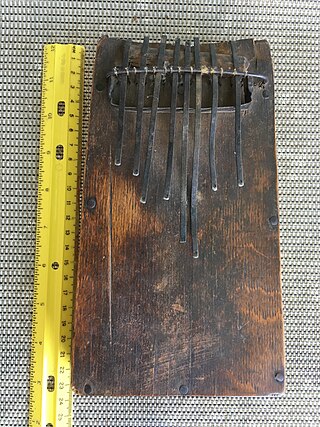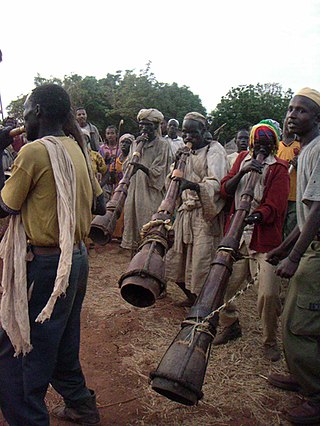
The Nilo-Saharan languages are a proposed family of around 210 African languages spoken by somewhere around 70 million speakers, mainly in the upper parts of the Chari and Nile rivers, including historic Nubia, north of where the two tributaries of the Nile meet. The languages extend through 17 nations in the northern half of Africa: from Algeria to Benin in the west; from Libya to the Democratic Republic of the Congo in the centre; and from Egypt to Tanzania in the east.
Shabo is an endangered language and likely language isolate spoken by about 400 former hunter-gatherers in southwestern Ethiopia, in the eastern part of the South West Ethiopia Peoples' Region.

Benishangul-Gumuz is a regional state in northwestern Ethiopia bordering Sudan. It was previously known as Region 6. The region's capital is Assosa. Following the adoption of the 1995 constitution, the region was created from the westernmost portion of the Gojjam province, and the northwestern portion of the Welega Province. The name of the region comes from two peoples – Berta and Gumuz.

The Koman languages are a small close-knit family of languages located along the Ethiopia–Sudan border with about 50,000 speakers. They are conventionally classified as part of the Nilo-Saharan family. However, due to the paucity of evidence, many scholars treat it as an independent language family. Among scholars who do accept its inclusion within Nilo-Saharan, opinions vary as to their position within it.
Berta proper, a.k.a. Gebeto, is spoken by the Berta in Sudan and Ethiopia. As of 2006 Berta had approximately 180,000 speakers in Sudan.
The Surmic languages are a branch of the Eastern Sudanic language family.

The languages of Ethiopia include the official languages of Ethiopia, its national and regional languages, and a large number of minority languages, as well as foreign languages.
Mao-Komo is a woreda in Benishangul-Gumuz Region, Ethiopia. Because it is not part of any zones in Benishangul-Gumuz, it is considered a Special woreda, an administrative subdivision which is similar to an autonomous area. The southernmost woreda in the Region, Mao-Komo is bordered on the west by Sudan and South Sudan, on the north by the Assosa Zone, and on the east and south by the Oromia Region. Towns in this woreda include Tongo, which has a weekly market. The Tongo refugee camp, housing 12,483 displaced people from Sudan and South Sudan, is also located in Mao-Komo.

The Majang people, or Majangir, live in southwestern Ethiopia and speak a Nilo-Saharan language of the Surmic cluster. The 1998 census gave the total of the Majangir population as 15,341, but since they live scattered in the hills in dispersed settlements, their actual total number is undoubtedly much higher. They live around cities of Tepi, Mett'i, and scattered southwest of Mizan Teferi and towards Gambela.

The Berta (Bertha) or Funj or Benishangul are an ethnic group living along the border of Sudan and Ethiopia. They speak a Nilo-Saharan language that is not related to those of their Nilo-Saharan neighbors. The total population of Ethiopian-Bertas in Ethiopia is 208,759 people. Sudanese-Bertas number around 180,000.
The Uduk are a Nilo-Saharan group from southeastern Sudan. They speak Uduk, a Koman language. They call themselves Kwanim Pa and are culturally and linguistically related to neighboring communities, such as the Gumuz and the Kwama from the Sudan-Ethiopia borderland. Due to the recent war in southern Sudan they have been forced to emigrate to other countries, especially Ethiopia. Following the peace agreement in 2005, some Uduk have started to return home.

The Kwama, are a Nilo-Saharan-speaking community living in the Sudanese-Ethiopian borderland, mainly in the Mao-Komo special woreda of the Benishangul-Gumuz Region in Ethiopia. They belong, culturally and linguistically, to the Koman groups, which include neighboring communities such as the Uduk, Koma, and Opuuo. Although they traditionally occupied a larger territory, they have been forced to move to marginal, lowland areas by the Oromo from the 18th century onwards. In some villages Kwama, Oromo and Berta live together. The Kwama are often called "Mao" by other groups, especially by the Oromo. The people who live in the southern area and near the Sudanese borderland often call themselves "Gwama" and use the term "Kwama" to refer to those living further to the south and in Sudan. These other "Kwama" are usually known by anthropologists as Koma or Komo. In recent years, many people belonging to this ethnic group have been resettled by the Ethiopian state in order to provide them with clinics and schools.

The Majang language is spoken by the Majangir people of Ethiopia. Although it is a member of the Surmic language cluster, it is the most isolated one in the group. A language survey has shown that dialect variation from north to south is minor and does not seriously impede communication. The 2007 Ethiopian Census lists 6,433 speakers for Majang (Messengo), but also reports that the ethnic group consists of 32,822 individuals. According to the census, almost no speakers can be found in Mezhenger Zone of Gambela Region; a total of eleven speakers are listed for the zone, but almost 10,000 ethnic Mejenger or Messengo people.
The Bʼaga languages, also known as Gumuz, form a small language family spoken along the border of Ethiopia and Sudan. They have been tentatively classified as closest to the Koman languages within the Nilo-Saharan language family.
The Komuz languages are a proposed branch of the Nilo-Saharan language family which would include the Koman languages, the Gumuz languages and the Shabo language, all spoken in south-eastern Sudan and western Ethiopia. Nilo-Saharan specialists have vacillated on a genealogical relationship between the Koman and Gumuz languages, a relationship called Komuz. Greenberg (1963) had included Gumuz in the Koman language family. Bender classified them together in a distant relationship he called Komuz, but by 1996 he had reversed himself, though he kept both groups in core Nilo-Saharan. Dimmendaal (2008) kept them together, though expressed doubts over whether they belonged in Nilo-Saharan, later referring to Gumuz as an isolate (2011). Ahland, on the basis of new Gumuz data, resurrected the hypothesis. Blench (2010) independently came to the same conclusion and suggested that the Shabo language might be a third, outlying branch. The classification of Shabo is difficult because of a strong Koman influence on the language that is independent of any genealogical relationship between them. Schnoebelen (2009), moreover, sees Shabo as a likely isolate.
Komo is a Nilo-Saharan language spoken by the Kwama (Komo) people of Ethiopia, Sudan and South Sudan. It is a member of the Koman languages. The language is also referred to as Madiin, Koma, South Koma, Central Koma, Gokwom and Hayahaya. Many individuals from Komo are multilingual because they are in close proximity to Mao, Kwama and Oromo speakers. Komo is closely related to Kwama, a language spoken by a group who live in the same region of Ethiopia and who also identify themselves as ethnically Komo. Some Komo and Kwama speakers recognize the distinction between the two languages and culture, whereas some people see it as one "ethnolinguistic" community. The 2007 Ethiopian census makes no mention of Kwama, and for this reason its estimate of 8,000 Komo speakers may be inaccurate. An older estimate from 1971 places the number of Komo speakers in Ethiopia at 1,500. The Komo language is greatly understudied; more information is being revealed as researchers are discovering more data about other languages within the Koman family.

The Berta languages, or Funj, traditionally considered dialects of a single language, are Gebeto, Fadashi, and Undu. They are either a small family of their own, or a primary branch of the Nilo-Saharan language family.
Gumuz is a dialect cluster spoken along the border of Ethiopia and Sudan. It has been tentatively classified within the Nilo-Saharan family. Most Ethiopian speakers live in Kamashi Zone and Metekel Zone of the Benishangul-Gumuz Region, although a group of 1,000 reportedly live outside the town of Welkite. The Sudanese speakers live in the area east of Er Roseires, around Famaka and Fazoglo on the Blue Nile, extending north along the border. Dimmendaal et al. (2019) suspect that the poorly attested varieties spoken along the river constitute a distinct language, Kadallu.
Kadallu is a poorly attested Gumuz language of southeastern Sudan. It is known only from two short word lists. It is spoken on the Blue Nile in the southeastern corner of Sudan, in the area surrounding Ad-Damazin and Er Roseires, and just south-southeast of Famaka near the Ethiopian border.

The Benishangul-Gumuz conflict was an armed conflict mostly in the Metekel Zone of the Benishangul-Gumuz Region in Ethiopia that started in 2019, until peace agreement signed between the rebel groups and the government of Ethiopia in October 2022.









